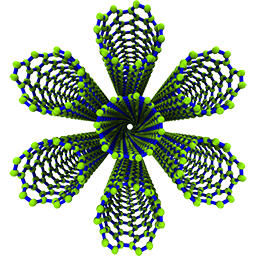# -*- coding: utf-8 -*-
"""
===============================================================================
Unrolled SWNT generator (:mod:`sknano.generators.unrolled_swnt_generator`)
===============================================================================
.. currentmodule:: sknano.generators.unrolled_swnt_generator
.. todo::
Add methods to perform fractional translation and cartesian translation
before structure generation.
.. todo::
Handle different units in output coordinates.
"""
from __future__ import absolute_import, division, print_function, \
unicode_literals
__docformat__ = 'restructuredtext en'
import copy
# import numpy as np
from sknano.core import pluralize
from sknano.core.atoms import StructureAtom as Atom, StructureAtoms as Atoms
from sknano.core.crystallography import SuperCell
from sknano.core.math import Vector
from sknano.core.structures import UnrolledSWNT
from .base import NanoStructureGenerator
__all__ = ['UnrolledSWNTGenerator']
[docs]class UnrolledSWNTGenerator(NanoStructureGenerator, UnrolledSWNT):
"""Class for generating unrolled nanotube structures.
.. versionadded:: 0.2.23
Parameters
----------
n, m : int
Chiral indices defining the nanotube chiral vector
:math:`\\mathbf{C}_{h} = n\\mathbf{a}_{1} + m\\mathbf{a}_{2} = (n, m)`.
nx, ny, nz : int, optional
Number of repeat unit cells in the :math:`x, y, z` dimensions
basis : {:class:`python:list`}, optional
List of :class:`python:str`\ s of element symbols or atomic number
of the two atom basis (default: ['C', 'C'])
.. versionadded:: 0.3.10
element1, element2 : {str, int}, optional
Element symbol or atomic number of basis
:class:`~sknano.core.Atom` 1 and 2
.. deprecated:: 0.3.10
Use `basis` instead
bond : float, optional
:math:`\\mathrm{a}_{\\mathrm{CC}} =` distance between
nearest neighbor atoms. Must be in units of **Angstroms**.
Lx, Ly, Lz : float, optional
Length of bundle in :math:`x, y, z` dimensions in **Angstroms**.
Overrides the :math:`n_x, n_y, n_z` cell values.
.. versionchanged:: 0.4.0
Changed units from nanometers to **Angstroms**
fix_Lz : bool, optional
Generate the nanotube with length as close to the specified
:math:`L_z` as possible. If `True`, then
non integer :math:`n_z` cells are permitted.
autogen : bool, optional
if `True`, automatically call
:meth:`~UnrolledSWNTGenerator.generate`.
verbose : bool, optional
if `True`, show verbose output
Notes
-----
The `UnrolledSWNTGenerator` class generates graphene using the
nanotube unit cell defined by the chiral vector
:math:`\\mathbf{C}_{h} = n\\mathbf{a}_{1} + m\\mathbf{a}_{2} = (n, m)`.
If you want to generate graphene with an armchair or zigzag edge using
`length` and `width` parameters, see the
:class:`~sknano.generators.GrapheneGenerator` class.
.. seealso:: :class:`~sknano.generators.GrapheneGenerator`
Examples
--------
First, load the :class:`~sknano.generators.UnrolledSWNTGenerator`
class.
>>> from sknano.generators import UnrolledSWNTGenerator
Now let's generate an unrolled :math:`\\mathbf{C}_{\\mathrm{h}} = (10, 5)`
SWCNT unit cell.
>>> unrolled_swnt = UnrolledSWNTGenerator(10, 5)
>>> unrolled_swnt.save()
The rendered structure looks like:
.. image:: /images/unrolled_1005_1cellx1cell-2.png
"""
[docs] def generate(self, finalize=True):
"""Generate structure data."""
self.structure.clear()
layer0 = Atoms()
scaling_matrix = self.scaling_matrix
supercell = SuperCell(self.unit_cell, scaling_matrix)
for atom in supercell:
layer0.append(Atom(**atom.todict()))
layer0.center_centroid()
lattice_shift = Vector(p0=supercell.basis.centroid,
p=layer0.centroid)
lattice_shift.z = self.nlayers * lattice_shift.z
self.lattice_shift = Vector(lattice_shift)
for nlayer in range(self.nlayers):
layer = copy.deepcopy(layer0)
layer.translate(Vector([0, nlayer * self.layer_spacing, 0]))
[setattr(atom, 'mol', nlayer + 1) for atom in layer]
if (nlayer % 2) != 0:
layer.translate(self.layer_shift)
layer.rotate(angle=self.layer_rotation_angles[nlayer], axis='z')
self.atoms.extend(layer)
self.layers.append(layer)
if finalize:
self.finalize()
@classmethod
[docs] def generate_fname(cls, n=None, m=None, nx=None, nz=None,
fix_Lx=False, fix_Lz=False, **kwargs):
fname = '{}{}'.format('{}'.format(n).zfill(2), '{}'.format(m).zfill(2))
nx_fmtstr = '{:.2f}' if fix_Lx else '{:.0f}'
nx = ''.join((nx_fmtstr.format(nx), pluralize('cell', nx)))
nz_fmtstr = '{:.2f}' if fix_Lz else '{:.0f}'
nz = ''.join((nz_fmtstr.format(nz), pluralize('cell', nz)))
cells = 'x'.join((nx, nz))
return '_'.join(('unrolled', fname, cells))
[docs] def save(self, fname=None, outpath=None, structure_format=None,
center_centroid=True, **kwargs):
"""Save structure data.
See :meth:`~sknano.generators.GeneratorBase.save` method
for documentation.
"""
if fname is None:
fname = self.generate_fname(n=self.n, m=self.m,
nx=self.nx, nz=self.nz,
fix_Lx=self.fix_Lx,
fix_Lz=self.fix_Lz)
if center_centroid:
self.atoms.center_centroid()
super().save(fname=fname, outpath=outpath,
structure_format=structure_format,
center_centroid=False, **kwargs)
